Presented here is a sampling of the power protection devices currently available, taken from new product information provided by the manufacturers. The protection mentioned is that claimed by the manufacturer and has not been confirmed by this magazine.
By Conrad Persson
Most people don't think about power very much. We take for granted that electrical power that's adequate for whatever electrical appliances we choose to use in the house will be delivered by the power company. In most cases, that assumption is correct. For electric lights, motors and similar equipment, the power delivered by the utility is perfectly adequate.
Even in the case of electronic products, the power is almost always adequate. But just because the power is adequate, that doesn't mean that it doesn't cause problems with some of the more sophisticated electronic products we use.
Most of the food we eat gives us the nutrients we need to operate our bodies, but if the food contains contaminants or inimical bacteria, we may get sick. If you give your car a steady diet of clean gasoline, it will perform as expected. Given a tankful of gas that contains dirt, moisture or other contaminants, it might run rough, refuse to start or even worse, be damaged enough to need repair.
You can't see the contaminants in your food that might make you sick, but by selecting your food carefully and cooking it properly, you can avoid most problems. By being careful where you buy your gas and changing your gas-line filter occasionally, you may be able to avoid most causes of damage to your car's engine.
-------------

Figure 1.
VOLTAGE SURGE CONDITION SURGE (10 to 35% above normal lasting from 16ms to 30s)
NOMINAL VOLTAGE POWER FACTOR CORRECTION SPIKE TRANSIENT DISTURBANCES VOLTAGE SAG CONDITION SAG (10 to 35% below normal, lasting 16ms to 30s)
NOMINAL VOLTAGE TRANSIENT OVERVOLTAGE (1 to 100 times above nominal voltage, lasting up to 15ms)
POWER INTERRUPTION (lasting 33 to 133ms)
MOMENTARY POWER INTERRUPTION
-------------------
Unfortunately, you can't shop for your electrical power, so if your local utility is giving you dirty power, you're stuck with it. But if that is the case, just as contaminated food will make you sick and contaminated gasoline can damage your engine, contaminated power may damage some con sumer electronic products.
Causes of power problems
Utilities don't willfully transmit contaminated power. Ordinarily they take great pains to make sure that the voltage and frequency are within specifications. Actually, when you think about the fact that we expect to have adequate power available to our homes 24 hours a day, every day of the year, year in and year out without even the occasional Sunday off, the utilities do a remarkable job.
In spite of power companies' best efforts, though, the nice smooth 60Hz sine wave coming down the wire is subjected to many kinds of aberrations that may cause it to deviate from its nominal conditions, or that may superimpose spurious electrical signals on the 60Hz signal. Here are some of the problems, their causes and their possible effects on consumer electronic devices.
Undervoltage--Undervoltage is the term for the existence of a lower-than-normal voltage on the ac line over an extended period of time. Another term for this phenomenon is brownout. In some cases, this condition is imposed intentionally by the utility company during periods of heavy usage in order to spread less-than-adequate power production capacity over all their customers, rather than cut off some of their customers.
In other cases, a brownout may be unintentional, occurring simply as a result of excessive power consumption causing excessive voltage drop on certain lines, resulting in decreased voltage at the outlets of customers.
Undervoltage is frequently damaging to such things as electric motors, which may run less efficiently, overheat and become damaged. Most electronic products are relatively unaffected by moderate levels of undervoltage because of built-in tolerances and regulation. Significant undervoltages may drop below the threshold voltage value needed by an electronic product and cause it to cease operation entirely.
--------------------
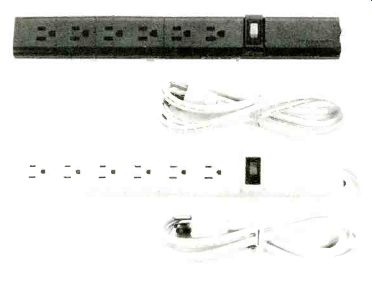
These two 6-outlet surge suppressors available from RCA are the Power Safe, which protects equipment powered by this device from transient voltages, and the Power Safe Plus, which protects against transients and also filters out noise with a high frequency bidirectional filter.
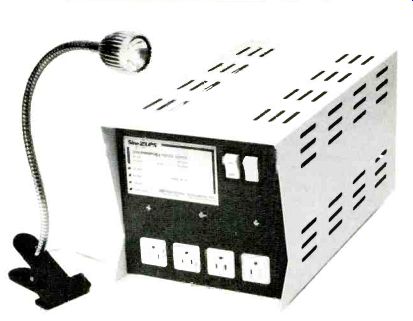
An on-line, sine wave uninterruptible power supply, from Electronic Specialists
Inc., supplies up to 20 minutes of power during extended power outages.
Wideband EMI/RFI filtering and high-speed, high-current suppression are incorporated. Included is integral overload/short circuit protection.

The Smart. Strip III from Pilgrim Electric Company protects equipment from
transient over-voltages and line noise. One of the outlets is a Smart Socket,
into which you plug whichever piece of equipment that you wish to have come
on first. When the device plugged into the Smart Socket is switched on and
begins drawing current, the rest of the outlets are automatically turned on.
--------------
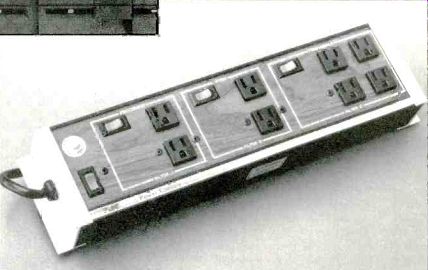
This combination ac line filter and transient surge suppressor, the model 023 from PMC Industries, features three separate filter banks and surge suppressor circuits, each individually switch/lighted. This construction allows protection not only from the incoming line, but from other instruments plugged into other filter banks.
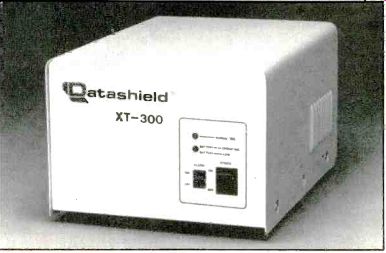
The Datashield Model XT-300 backup power source by PTI Industries is a battery-operated,
self-contained power generator that supplies even, uninterrupted ac power
to a microcomputer in the event of a power drop or outage. In addition, it
also provides surge protection, which filters and eliminates any voltage spikes
or surges above 140V, as well as line noise from nearby appliances.
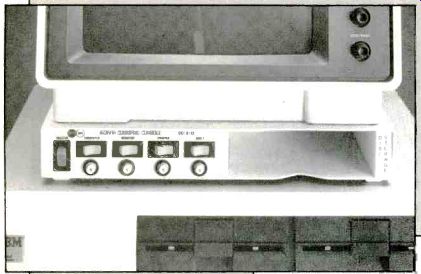
The Isobar Command Console, available from Tripp Lite, provides a centralized
power control console complete with full spike/surge and RFI/noise protection
for computers and peripherals. The unit, which incorporates an individual
circuit breaker for each duplex receptacle, is designed to be located between
a personal computer and the monitor, and offers a diskette storage compartment.
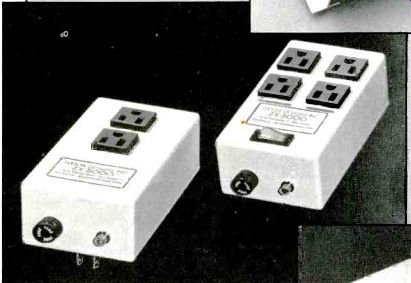
The ZX-5000 Extended Range surge/ spike/noise suppressors by Sutton Industries,
based upon a new hybrid protection circuit and filter bank system, have a
rated energy dissipation of 450J, a rated power dissipation o' over 4,500,000W
in 100ms, a voltage withstand capability of 25,000V, a short term current
rating of 20,000A, less than a 5ps response time, a clamping voltage of 195VP/138Vrms
and a let-through voltage of 240VP/170Vrms.
----------
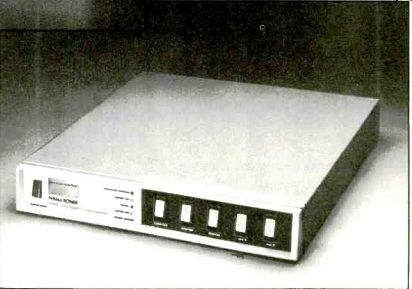
The Power Commander II from Perma Power Electronics Inc. is a power control center that incorporates both computer and telephone line surge suppressors. The 5-outlet power control center, which features fingertip control for computer, monitor., printer and more, has a surge suppressor employing two 4-element, 2-stage filters in a coordinated circuit, using a combination of metal oxide varistors and silicon avalanche diodes that provides protection against both normal and common mode power surges.

The PowerMax from Panamax provides protection for microcomputers and word
processing systems. It is effective in eliminating cline disturbances (surges)
or loss of power. The units come in 250W, 400W and 800W output and provide
voltage surge, brownout, noise and power failure protection and a maintenance--free
rechargeable battery for power continuity in case of power failure.

The Safe SPS200A and SPS400A from Safe Power Systems Inc. are backup power
systems that turn on in less than one-third cycle, protecting the data and
memory of a connected microcomputer, as well as providing built-in surge suppression
They provide power line synchronization, giving a smooth transition to standby
power. The 200A unit, recommended for floppy disk applications, provides standby
power for a minimum of 20 minutes. For larger, hard disk systems, the 400A
provides standby power for a minimum of 10 minutes, giving an operator enough
time to go through an orderly shutdown procedure.
A final precaution
Before you purchase any kind of power protection device, it might not be a bad idea to do some research to make sure it will do what you need it to do reliably. And if you do get one of them and use it, unless you're 100% sure that it's designed to protect both you and your electronic equipment from close lightning strikes or when there are thunderstorms in the area, the old precaution about electrical and electronic equipment still applies: Turn it off, unplug it and leave it alone.
------------
Overvoltage--Overvoltage is the term for the existence of a higher--than-normal voltage on the power line for an extended period of time.
Whether or not an overvoltage condition causes a problem with consumer electrical or electronic equipment will depend on the level of the overvoltage and the nature of the equipment. This is a rare condition, but if it occurs it can cause stress on equipment and may result in premature failure.
Sags--This is a drop in line voltage for one or a few cycles, and may be caused by the turn-on of equipment that consumes large quantities of power, such as heavy industrial equipment. Unless sags are prolonged or especially deep, they are probably insignificant, probably won't even be noticed.
Surges--These are increases in line voltage over the nominal value occurring for one or a few cycles and may be caused when heavy equipment is turned off. As with sags, ordinarily these will not cause problems unless they are large or prolonged.
Dropouts--A dropout is a complete loss of power that exists for less than one cycle. Most household electrical/electronic equipment will not notice these, but personal computers or computer--based devices may be disrupted.
Transients--Transients such as voltage spikes may be impressed on the power line by a number of sources. The inductive kickback when a motor is turned off, in the industrial plant down the road or in your home, might send a spike of a few volts or hundreds of volts down the wire that could cause a personal computer or a microcomputer-based product to malfunction momentarily, or even cause significant damage to some of the components and premature failure of the unit.
The effects of power line problems
Most of these power line problems do not pose serious threats to consumer electronics equipment, because most consumer electronics equipment is designed to tolerate some degree of input voltage variation. Unless they're excessive, undervoltages, over-voltages, sags and surges will probably not even be noticed by televisions, stereos and other electronic devices found in the home.
With today's sophisticated computer-based equipment, the power line problems most likely to cause trouble are the brief, abrupt fluctuations in line voltage: dropouts and transients.
In the case of a dropout, the absence of power is so brief that there probably won't be any indication that anything happened to the power. If there's a microcomputer, or microcomputer-based equipment connected to the line, though, it may exhibit some strange behavior; possibly turn out some erroneous results. If, for example, a dropout occurred resulting in a too-low level of voltage on the logic circuits during a computer operation involving writing to memory, the result might be some bad data in the memory, and possibly crashing of the program.
A transient is capable of causing anything from no problem to total failure of the system, depending on the nature and magnitude of the transient and the degree of sensitivity of the device to transients.
A very brief, low value of transient might not even be noticed. A somewhat more powerful transient might appear to the system to be a logic pulse and result in erroneous bits being placed into memory. A little more intensity and a transistor might suffer a slight amount of damage, starting it on its way to eventual failure. If the transient is of sufficient intensity, any modern electronics device with voltage-sensitive components that happens to be connected to the line and turned on might be severely damaged.
Avoiding power line problems
Unless you use a power line monitor, you probably won't know for sure whether the utility power coming into your house is carrying with it damaging transients. Unless you are certain that it is not, you probably will be correct in assuming that it is. That being the case, it really makes sense to protect any delicate electronics equipment: television, VCR, stereo, computer, with some form of transient protection.
Unfortunately, selecting a power protection product is not as easy as it sounds. There is a broad range of devices ranging from spike suppressors that cost from $20 to $100 up to uninterruptible power supplies that may cost several hundred dollars. To make matters worse, some of the products on the market are of limited effectiveness: They may keep low-energy transients out of your equipment but allow a lot of the energy from higher-energy transients through to damage your equipment.
Another problem sometimes encountered with transient protection products is that, in some cases, the protection unit itself may be damaged by a powerful transient, and unless there is some method of indicating this situation, you may be relying on protection that no longer exists, a situation that's worse than having no protection device at all.
Adding in protection In some cases, you might prefer to incorporate transient suppression into the unit you wish to protect rather than install a plug-in suppressor, say because you might move the protected device around and leave the suppression device where it is.
Or, if you want to be doubly safe, wear belt and suspenders so to speak, you might want to do both.
Philips ECG, which offers its own plug-in voltage surge suppressors, such as the EMF-2 (two prong) and EMG-3 (three prong) single-outlet units, the EMF-33 3-outlet unit and the EMF-315 Power Pure voltage surge and noise protector, also mentions the possibility of adding suppression to consumer electronic products.
ECG's periodical "Counter Points," Vol. 8 No. 2, contains some suggestions on putting transient suppression components right inside the product to be protected. Specifically, they suggest placing a MOV across the ac line after the fuse, the largest MOV that will fit, with an ac voltage rating of 150V. Another suggested precaution is to place a thermal cutout rated for 77°C in series with the line and tape it to the MOV so that if the MOV becomes hot from handling repeated surges, the circuit will open and let you know something's wrong.
Also see: Why do components fail?